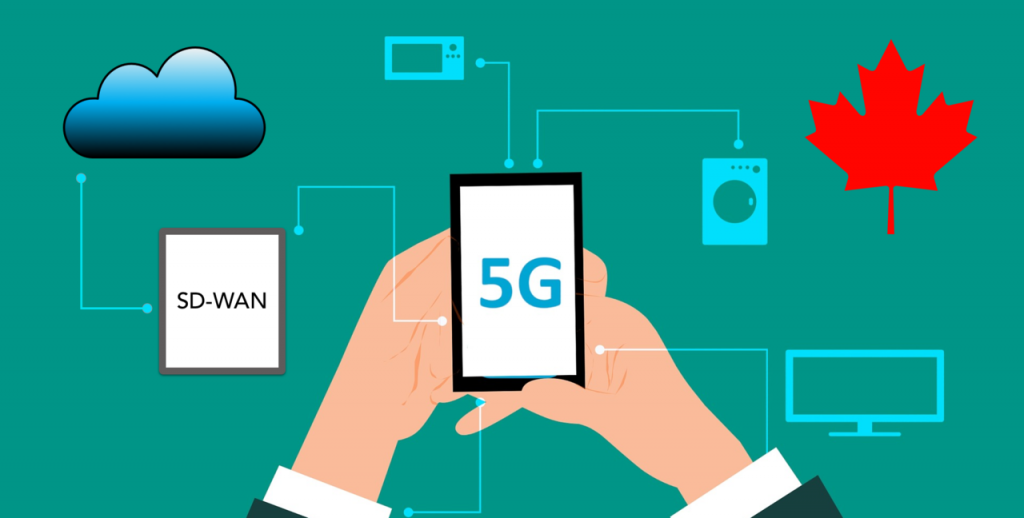In my last article, I discussed cloud storage services and the impact of latency on storage and network performance. Afterwards, Beanfield techs fielded a number of customer inquiries asking us if 5G wireless or Software Defined Wan (SD-WAN) products could help customers overcome network latency issues when connecting to the cloud.
As an employee of a Canadian fibre optic network carrier, declaring that the epic hype building around 5G wireless is setting up Canadian businesses and consumers for disappointment will make me an unpopular person in a few tech circles. From a self-serving sales perspective, 5G wireless WILL drive more demand for my company’s fibre optic network connectivity than any other wireless technology upgrade in history. The smart move would probably be shutting up and riding that sweet 5G wholesale fibre contract boom on the horizon. It would certainly be easier than disappointing eager 5G and SD-WAN hype beasts with bad news. But, my passion for my career is only matched by how lucky I feel I am to work on cutting edge case studies in partnership with some of the most forward-thinking businesses in the Canadian market. Beanfield Cloud Exchange customers are actively breaking new ground every day, working to find new applications for Cloud IaaS, SaaS, and PaaS services that accelerate projects in the Film & TV production, VFX, VR, and Finance industries. It is because this work means so much to me, and our customer success is so important to Beanfield, that I think it is time to rain on both the 5G and SD-WAN parades. The truth is Canada is a unique market; we have a sparsely populated country, and none of this network technology is magic. I’m sure some of your IT provider’s insights on the future of networking and the cloud are valuable, but not addressing this prevalent and fundamental misunderstanding of the limitations of these new paradigms in connectivity will translate epic hype into epic disappointment.
Why 5G Wireless or SD-WAN Services Won’t Solve Most Network Issues for Canadians
1. The Speed Limit Is The Speed of Light Over Fibre
The most significant improvement in the jump between 4G and 5G wireless technology is LATENCY. If you are familiar with some of my previous articles, network latency is the key to the cloud kingdom. The first 5G wireless technology tests revealed amazing leaps forward. Initial demonstrations show that the latency between a wireless device and a base station can be reduced to 1–2ms. This is undeniably amazing news, and this will be a transformative change for wireless. The bad news, however, is that a mobile device and the base station are literally the very last couple of hundred metres in an expansive network connection that could very well cover hundreds of kilometres of physical space. Just like terrestrial last-mile services; wireless base stations still connect to fibre optic cables, and then to Multiprotocol Label Switching (MPLS) core routers, data always travels back to wire centres and still has to traverse the public internet AND BACK so you can read this awesome Medium article. 5G can’t and won’t ever change that, and saying it will is like saying your flight has been upgraded to first class but all you’ve done is put more comfortable chairs in the departure terminal.

Unless 5G wireless is a Real Estate play, where Canadians collectively relocate to Ashburn or Portland, businesses and customers need to brace themselves for less than mindblowing connectivity to their existing cloud services over 5G networks.
Understandably, right now most companies are evaluating SD-WAN products and eagerly awaiting next-gen wireless services because of the high price of legacy MPLS mesh and enterprise fibre network products from the Big Three. Modern businesses require high-performance point-to-point private networking, there is no way around it. But dreaming of maintaining or even improving the performance of that private network by replacing it with SD-WAN services is a dream that will go unrealized. The reality for SD-WAN is much the same as 5G wireless. Latency across the entire route always limits connection performance. Glueing together a 1Gig IP transit link (internet connection) with a VDSL or LTE backup service using SD-WAN magic will only save money. After the penny has been pinched, the likeliest outcome will be disappointed users when your company finally trades in those expensive 100Mb and burstable 1G EVPL circuits. Replacing legacy services with multiple internet connections adds jitter, hops, and latency to that mesh network, it doesn’t remove those limitations. As we discussed last time; the 1500 MTU limit of the internet, the additional packet overhead of the VPN/SD-WAN protocols, and the cloud centralization of hub-and-spoke SD-WAN mesh architectures effectively move your business, data, and users further away from branch offices, data centres, and cloud on-ramps. Companies are better to pivot to a more cost-effective carrier ethernet service from another company, instead of calling Big Blue to switch that old MPLS network out for their new Virtual Network Service.
2. Carriers Couldn’t Build Enough Fibre To Support 5G If We Tried
The second most significant improvement between 4G and 5G are the promised blazing fast topline wireless speeds. I’m sure a quick search through the Medium library will return dozens of articles raving about 5G bringing 1Gbps and 10Gbps wireless connectivity to homes and mobile devices. Some keen authors predict the 5G future will be the end of FTTH/B (Fibre-to-the-Home/SMB) internet services or even the need for WiFi.

Every tech bro telling customers and companies that 5G is the end of fibre optic cabling obviously doesn’t realize that 5G wireless base stations don’t work without installing EVEN MORE fibre optic cabling than the old ones used. For ISPs and wireless providers to deliver on those super high speeds, their service backbones require orders of magnitude more fibre capacity than we have available in the Canadian market currently. On top of that, the 5G radio signals travel a very short distance and may require a radiodensity up to 40x the density of the existing 4G network footprints. This means carrier routing cores need MASSIVE upgrades and dramatic increases in peering and IP transit capacity. Without any of this, 5G wireless technology would have the effect of hooking up a massive firehose to the sprinkler in your front lawn. 5G wireless is a big pipe that users expect new applications to fill when the technology finally launches. Meeting that demand is no small task. Given the high cost of new technologies at market launch, the length of time it will take to roll 5G out, and the time needed for behaviours to change in the general population (even when the service is available and economical), your FTTH/B or enterprise fibre internet connection is probably here to stay and I would count on it being there for the long-haul. Post service launch; if there is a cost-effective, fast, reliable, and secure fibre service available in your office suite, does it really make sense to trade that in for a 5G wireless solution?
3. Canada Is A Big Lonely Place And The Rural/City Service Divide Is About to Get Worse
Geographically, Canada is a difficult landscape for 5G wireless because the population is spread out over a great distance. Cities will be a little easier to roll out 5G in service because small cell base station deployments can be installed on the roofs of buildings. But every single commercial building with a base station will need numerous bundles of net-new high count fibre runs pulled inside to support those installations. Just considering Toronto, if each base station has 500x 1G or 10G mobile devices connected to its radio, to deliver the topline network speed consumers will think they are paying for, that radio will require a core network feed with 500Gbps and up to 5Tbps (TERABITS/s) of network throughput capacity. If Bell, Telus, Rogers, and Shaw focused exclusively on delivering 5G wireless beside the coast-to-coast highways, the fibre builds would need to start today so those companies could finally turn on 5G along the Trans Canada within a decade. A while back, the literal geniuses at Google and Sidewalk Labs identified the global fibre capacity issue that 5G creates, specifically the epic lack thereof, and have ALREADY invented new optical lasers to upgrade the capacity of existing fibre assets!

But don’t spike your Pixel 3 on the floor and touchdown dance yet, because those lasers aren’t going to be commercially available for a long time, and for sure won’t be part of the first few waves of 5G service releases. Cisco, Huawei, Samsung, Nokia, and Ericsson aren’t even testing the new Google lasers yet, because the not-for-profit IEEE democratic consortium of engineers that govern and approve network technology standards (so the entire internet can inter-operate) haven’t finished approving Google’s Super-PON spec. It’s the classic “f*#$ you, pay me” conundrum that arises anytime you tell someone doing something for free to hurry up.

For companies with branch offices in rural communities that are being raked over the coals paying for high-cost and low-speed MPLS services, I feel your pain. SD-WAN products can probably help, but don’t expect to bridge the rural/urban divide with a new cutting edge box. I think companies have an obligation to dump expensive MPLS services if they can, to motivate big telecom companies to innovate or rationalize their pricing. The industry secret is that Canadian Hydro Operators are going to great lengths to quickly string fibre optic cables along hydro poles because the wireless carriers desperately need fibre connectivity in rural areas. So even though Northern Bruce River Peninsula Hydro might not be top of mind when you think of commercial fibre services, your local hydro operator might actually surprise you with the connectivity they have available for you right now in your rural market. Most people simply aren’t aware these services existed. Operating as side project within a public sector company has implications for the marketing dollars these rural utility companies have to announce that fibre is now available in your area. You’ll have to trust me that the Hydro Telco sales guy is just waiting for your call. And his boss wants to make sure they’re doing just enough of this stuff to put their paws on some of the $1.7 billion earmarked for rural broadband in the latest federal budget.
4. If the Future Is Edge Computing Canada Needs to Start EDGING or At The Very Least, Build More Data Centres
A lot of the 5G hype is the potential for wireless Internet-of-Things (IoT) or cloud-delivered Artificial Intelligence (AI) applications once the wireless latency issue is solved. Manufacturers of micro IoT devices and Autonomous Vehicles are counting on 5G services for highspeed connectivity to offload computing operations to the cloud. Improved speeds and lower latency will allow manufacturers to keep technology footprints for these devices and applications small while achieving the scalability and performance needed by leveraging that RAW, TERRIFYING, AI computing power in AWS and GCP. But, even with 5G’s much lower wireless latency, cloud engineers already anticipate that AI computation power will need to be moved and delivered closer to the “edge” of existing networks. Basically, you want the AI service making the life-or-death decision for your car as close to the car as possible, as this maximizes the potential of you finally catching that nap on your drive to work safely. So what is EDGE Computing, besides a much more substantial and even more REAL sounding service, compared to cloud computing? Conceptually, it is the migration of services to microdata centres or small N-PoP compute node locations provided by the hyperscalers in local facilities where companies like AWS, Azure, and Google only have network equipment currently. In the United States, this isn’t a huge leap forward, but in Canada, our cities simply lack the the standard cloud compute or data centre capacity that US cities of comparable size have access to. It is far from trivial for Canada to catch up-it takes the facilities, tax incentives, cheap power and a skilled, and available workforce to expand existing data centres or start transforming every office building basement into a microservice server room. Toronto, for instance, only has two local hyperscalers with compute infrastructure, and one of them is ORACLE. Comparable US cities have as many as five. Capacity in our biggest city is LIMITED.

Most Canadian enterprises access cloud services out of data centres in Montreal, North Virginia, or Oregon. Any company east of Vancouver and West of Toronto is a long way from home if the future home of AI cars and IoT is in the cloud. Canada desperately needs to modernize our infrastructure and cities, if we really want to follow through with ambitious projects like the one with Sidewalk Labs and Waterfront Toronto. This will be the price of admission, and that will need to be addressed before we can dream of having AI cars on Canadian roads depending on AI platforms in local edge compute facilities in our cities.
Is There Any Good News For the SD-WAN or 5G Hype Beasts?
The good news is Canadian businesses are resilient and we always seem to defy the odds. Right now our unemployment and job creation numbers are defying fundamental principals of domestic economic output contraction, go figure. It will be disappointing for some having to watch our friends to the southern border enjoy the benefits of 5G wireless, SD-WAN, or Edge Computing right away. But this isn’t the first time in history we’ve lagged behind our bigger cousins. Canada’s population density (which is, from what I gather, our go-to excuse) might initially hold us back, but, having Canadian consumers waiting in anticipation for these next-gen services will drive local companies to innovate and adapt these new technologies to find a best fit for our market. This is an opportunity if nothing else, and Canadian companies will rise to the occasion, as we always have. I would love to be proven wrong by (and supply the fibre for) a super-fast and super-dense 5G network built by a hype beast. For the foreseeable future, my loonies are on companies like Beanfield Metroconnect, which will still be here installing much-needed fibre optic cabling, and continuing to upgrade our network. And until Canada is more densely populated or we all move to the US, dedicated fibre optic cabling will deliver the most cost-effective and high-speed network connectivity to your business. We understand that at the end of the day, all Canadians want the same things:

Hoverboards.
About Beanfield Metroconnect
Beanfield Metroconnect provides your business with the comprehensive service needed to connect your enterprise to the cloud directly. In January 2019, Beanfield Metroconnect was proud to announce with Amazon Web Services Canada that Beanfield was the first telecommunications company in Canada to be awarded an AWS Network Competency.
About the Author:

Daniel Simmons is the Director of Cloud Strategy at Beanfield Metroconnect, a cloud product manager, cloud evangelist, and a solution architect for cloud and data centre services. Daniel has spent the past year overseeing the launch of the Beanfield Cloud Exchange product with the goal of bringing multi-cloud connectivity to every office building in Toronto and Montreal. He lives in Toronto with his partner and dog.














